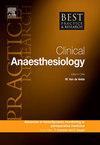esa在围手术期贫血管理中的作用:谁,什么,如何以及为什么?
IF 2.8
3区 医学
Q1 ANESTHESIOLOGY
Best Practice & Research-Clinical Anaesthesiology
Pub Date : 2023-12-01
DOI:10.1016/j.bpa.2023.10.002
引用次数: 0
摘要
术前贫血是常见的,与患者预后差和较高的输血率有关。围手术期输血也与不良预后相关。这些观察结果证明,在有中高出血风险的贫血患者手术前提高血红蛋白水平是合理的。促红细胞生成剂(ESAs)是上世纪80年代开发出来的,目前广泛用于治疗肾性和癌症相关性贫血。在围手术期,ESAs被成功地应用于90年代的术前献血计划。从那时起,已有大量证据表明,在手术前3-4周给予与铁相关的高剂量esa(理想情况下是静脉注射),可提高围手术期血红蛋白水平,并减少某些手术的输血需求。可能会提出不同的策略,从对所有血红蛋白低于13 g/dL的患者进行系统治疗(特别是在骨科和心脏手术中)到更个性化的贫血治疗方法(针对炎症或肾功能不全相关的贫血)。esa可能会增加包括血栓栓塞在内的不良事件的风险,对于高危患者(特别是接受癌症手术的患者),必须仔细权衡利弊比。欧空局使用的成本效益仍有待评价。本文章由计算机程序翻译,如有差异,请以英文原文为准。
ESAs in perioperative anemia management: Who, what, how and why?
Preoperative anemia is frequent and is associated with poor patient outcomes and higher transfusion rates. Perioperative blood transfusion is also associated with poor outcomes. These observations justify efforts to increase hemoglobin levels in anemic patients before surgeries with a moderate to high bleeding risk.
Erythropoiesis-stimulating agents (ESAs) were developed in the 80s and are now widely used for the treatment of renal and cancer-related anemia. In the perioperative settings, ESAs were successfully proposed for preoperative blood donation programs in the 90s. Since then, substantial evidence has been available demonstrating that high-dose ESAs associated with iron (ideally intravenously), administered 3–4 weeks before surgery, increase perioperative hemoglobin levels and reduce the need for blood transfusion in some surgeries. Different strategies might be proposed ranging from a systematic treatment for all patients with hemoglobin below 13 g/dL (especially in orthopedic and cardiac surgeries) to a more personalized approach to anemia treatment (targeting anemia related to inflammation or renal insufficiency). ESAs might increase the risk of adverse events, including thromboembolism, and the benefit-risk ratio must be carefully weighted for high-risk patients (particularly for those undergoing cancer surgery). The cost-effectiveness of ESA use remains to be evaluated.
求助全文
通过发布文献求助,成功后即可免费获取论文全文。
去求助
来源期刊

Best Practice & Research-Clinical Anaesthesiology
ANESTHESIOLOGY-
自引率
0.00%
发文量
37
审稿时长
36 days
 求助内容:
求助内容: 应助结果提醒方式:
应助结果提醒方式:


